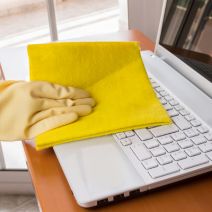 A clean computer is one that you can rely on. Like all other kinds of technology, a computer needs regular maintenance and cleanup sessions that preserve its working ability and prolong its life. Since January is Clean Up Your Computer Month, there’s no time like the present to ensure that your PC is squeaky clean. Here’s how you can give your computer and its components a comprehensive cleaning.
A clean computer is one that you can rely on. Like all other kinds of technology, a computer needs regular maintenance and cleanup sessions that preserve its working ability and prolong its life. Since January is Clean Up Your Computer Month, there’s no time like the present to ensure that your PC is squeaky clean. Here’s how you can give your computer and its components a comprehensive cleaning.
Before you start cleaning your PC, you should be sure to power the PC down and unplug it from the power supply. Doing so makes sure that you don’t accidentally damage both yourself or the PC while cleaning it.
The Monitor
Believe it or not, you might not immediately realize that your monitor is in need of some serious cleaning. Just take a good, hard look at it. Dirt, dust, fingerprints, and other grime can accumulate, giving your monitor a very nasty look. If your monitor is in especially gross condition, it might even be difficult to read what’s on the screen. Hopefully it never gets that way, but you should know that cleaning your monitor once in awhile can go great lengths toward enhancing your user experience.
The process is easy enough, as long as you keep one imperative rule in mind: Absolutely do not spray any liquids directly on the screen. Spraying something at the screen makes it much more difficult to control, which means that the chances of chemicals or water seeping into the monitor are greater. In most cases, your best bet is to use a damp cloth to wipe the monitor down. Water should work fine, but for LCD displays you’ll want to consider using rubbing alcohol. As always, take a minimal risk when cleaning the monitor, and you shouldn’t have any trouble. Once the screen is clean, all you have to do is vacuum away any remaining dust, and make sure that any monitor vents aren’t obstructed.
The Keyboard
As you might guess, the keyboard is the grimiest part of your PC setup. In fact, keyboards are known to hold more bacteria and germs than the average toilet seat. This is why it’s so important to clean your keyboard from time to time, if not regularly. Before starting, it’s important that your PC is powered down when you unplug the keyboard from the computer. If you’re using an older keyboard and you don’t power your PC down first, it could cause some severe problems, but it’s more likely that you’re using a USB-connected keyboard. Either way, make sure you shut down the PC, just to be safe.
First, you’ll want to make sure that you have a surface nearby that’s easy to wipe off. You’ll be turning your keyboard upside down and shaking it. Just take a moment to appreciate all of the nasty particles that accumulate underneath the keys. All of that is dust, food, and dead skin. Next, you should use a can of compressed air to dislodge some of the more stubborn particles. Depending on how nasty they are, you might have to remove keys to get the best clean. To safely remove a key, press down on the key directly beneath it, and insert a flat object (like a butter knife or a flat-head screwdriver) under the key. Apply the proper leverage and it should pop off easily enough. From there, it’s as simple as blowing compressed air and carefully wiping down surfaces that need it. As long as you haven’t spilled soda or coffee on your keyboard, this process should be good enough to achieve a decent level of cleanliness.
The PC Itself
Cleaning the rest of your PC is mostly a matter of looking at the fans on the computer casing. These fans are responsible for cooling the system, but when they start to collect dust, a PC might be at risk of overheating. An overheating PC can lead to serious long-term damage, like hardware failure or data loss. The best way to take the fight to this inevitable issue is to use a can of compressed air. Blow the dust away from the fan, not into the computer casing.
It’s a pretty good idea to give your PC a once-over with compressed air. Dust can accumulate on a piece of machinery that remains stationary for too long, and a computer is no exception. As mentioned before, steer clear of spraying any liquid anywhere inside or outside a computer, unless you know exactly what you’re doing. You don’t want to ruin any internal components of your PC while trying to clean it.
It’s a best practice to clean out your PC hardware every 6-to-12 months, but this can vary depending on how dusty your working area is. You’ll most likely be cleaning only the computer case fans, but it’s also a good idea to clean the inner mechanisms of your PC on occasion. Doing so can be dangerous without the oversight of a professional IT technician though, so proceed at your own risk. If you’re ever unsure of whether or not you’re handling your tech correctly, give Evolve IT a call. We’d be happy to advise you on PC cleaning best practices.
For more computer tips and tricks, be sure to subscribe to our blog.

